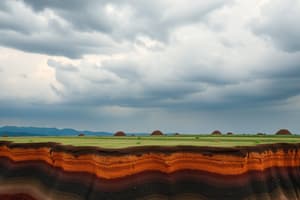Podcast
Questions and Answers
What is the definition of environment?
What is the definition of environment?
Surroundings or conditions in which a living organism is present.
What are the four segments of the environment?
What are the four segments of the environment?
Atmosphere, hydrosphere, lithosphere, and biosphere
Which of the following is NOT a segment of the environment?
Which of the following is NOT a segment of the environment?
- Atmosphere
- Lithosphere
- Biosphere
- Stratosphere (correct)
- Hydrosphere
The lithosphere is made up of minerals and soil.
The lithosphere is made up of minerals and soil.
What is the biosphere?
What is the biosphere?
What is the difference between a primary and a secondary pollutant?
What is the difference between a primary and a secondary pollutant?
Which of the following is a primary pollutant?
Which of the following is a primary pollutant?
Which of the following is a secondary pollutant?
Which of the following is a secondary pollutant?
What are the six major air pollutants?
What are the six major air pollutants?
What is the definition of environmental pollution?
What is the definition of environmental pollution?
Contaminants are substances that are naturally present in the environment.
Contaminants are substances that are naturally present in the environment.
What is a receptor in the context of environmental pollution?
What is a receptor in the context of environmental pollution?
What is a sink in the context of environmental pollution?
What is a sink in the context of environmental pollution?
Which of the following is NOT a type of environmental pollution?
Which of the following is NOT a type of environmental pollution?
What are the major causes of air pollution?
What are the major causes of air pollution?
Ozone is a primary pollutant.
Ozone is a primary pollutant.
What are the main health effects of air pollution?
What are the main health effects of air pollution?
What is ozone depletion?
What is ozone depletion?
What is the greenhouse effect?
What is the greenhouse effect?
What is global warming?
What is global warming?
Global warming is a natural phenomenon.
Global warming is a natural phenomenon.
Flashcards
Environment
Environment
The surroundings or conditions in which a living organism exists.
Atmosphere
Atmosphere
The outermost layer of the Earth's atmosphere, extending from approximately 500 to 1200 km above the surface.
Hydrosphere
Hydrosphere
The part of the Earth that includes all the water, such as oceans, lakes, rivers, and groundwater.
Lithosphere
Lithosphere
Signup and view all the flashcards
Biosphere
Biosphere
Signup and view all the flashcards
Pollutant
Pollutant
Signup and view all the flashcards
Environmental Pollution
Environmental Pollution
Signup and view all the flashcards
Contaminant
Contaminant
Signup and view all the flashcards
Receptor
Receptor
Signup and view all the flashcards
Sink
Sink
Signup and view all the flashcards
Water Pollution
Water Pollution
Signup and view all the flashcards
Water Pollutants
Water Pollutants
Signup and view all the flashcards
Air Pollution
Air Pollution
Signup and view all the flashcards
Smog
Smog
Signup and view all the flashcards
Particulates
Particulates
Signup and view all the flashcards
Acid Rain
Acid Rain
Signup and view all the flashcards
Greenhouse Gases
Greenhouse Gases
Signup and view all the flashcards
Indoor Air Pollution
Indoor Air Pollution
Signup and view all the flashcards
Natural Sources of Air Pollution
Natural Sources of Air Pollution
Signup and view all the flashcards
Human Sources of Air Pollution
Human Sources of Air Pollution
Signup and view all the flashcards
Carbon Monoxide (CO)
Carbon Monoxide (CO)
Signup and view all the flashcards
Ozone (O3)
Ozone (O3)
Signup and view all the flashcards
Nitrogen Dioxide (NO2)
Nitrogen Dioxide (NO2)
Signup and view all the flashcards
Sulfur Oxides (SOx)
Sulfur Oxides (SOx)
Signup and view all the flashcards
Carbon Dioxide (CO2)
Carbon Dioxide (CO2)
Signup and view all the flashcards
Lead (Pb)
Lead (Pb)
Signup and view all the flashcards
Greenhouse Effect
Greenhouse Effect
Signup and view all the flashcards
Global Warming
Global Warming
Signup and view all the flashcards
Chapman Cycle
Chapman Cycle
Signup and view all the flashcards
Ozone Depletion
Ozone Depletion
Signup and view all the flashcards
Study Notes
-
Environment
- Environment is the surroundings and conditions where living organisms exist.
- Environmental segments include the atmosphere, hydrosphere, lithosphere, and biosphere.
- Atmosphere: extends from 500 to 1200 km above the Earth's surface.
- Hydrosphere: encompasses water on, above, and below the Earth's surface.
- Lithosphere: contains minerals and soil.
- Biosphere: covers all living organisms.
Structure of the Earth
- The Earth's layers are:
- Crust (0-100 km thick)
- Asthenosphere
- Mantle (2900 km)
- Outer Core (liquid)
- Inner Core (solid)
- Layers' depths are given in the provided diagrams.
- Lithosphere includes crust part of upper mantle.
Major Elements in Different Sectors
- Atmosphere: Nitrogen (N), Oxygen (O)
- Ocean: Oxygen (O), Hydrogen (H), Chlorine (Cl), Sodium (Na), Magnesium (Mg), Sulfur (S)
- Sedimentary rocks: Oxygen (O), Silicon (Si), Aluminum (Al), Iron (Fe), Calcium (Ca), Potassium (K), Magnesium (Mg), Carbon (C), Sodium (Na)
- Granitic igneous rock: Oxygen (O), Silicon (Si), Aluminum (Al), Potassium (K), Sodium (Na), Calcium (Ca), Iron (Fe), Magnesium (Mg)
- Basaltic igneous rock: Oxygen (O), Silicon (Si), Aluminum (Al), Iron (Fe), Calcium (Ca), Magnesium (Mg)
- Mantle: Oxygen (O), Silicon (Si), Magnesium (Mg), Iron (Fe)
Pollutant
- Pollutant: a substance whose abundance is higher in nature than normal due to human activity and sometimes naturally.
- Pollutants impact the environment, living organisms, and mankind negatively.
- Examples are lead (Pb), sulfur dioxide (SO2), carbon dioxide (CO2).
- Pollutants originate from human activity (anthropogenic) or natural processes.
Environmental Pollution
- Environmental pollution: any undesirable change in physical, chemical, or biological characteristics of land, air, or water.
- Pollution harms humans, other life forms, industrial processes, living conditions, and cultural assets.
- Pollution wastes and deteriorates natural resources.
Contaminants
- Contaminants are substances not naturally present in the environment but introduced by human activity.
- An example is chlorine gas, which escaped from a derailed train in Florida, resulting in fatalities.
Receptor and Sink
- Receptor: medium affected by a pollutant (e.g., humans affected by photochemical smog).
- Sink: medium that retains and interacts with long-lived pollutants (e.g., marble wall interacting with sulfuric acid).
Types of Environmental Pollution
- Examples of environmental pollution include water pollution, air pollution, thermal pollution, light pollution, noise pollution, and land pollution.
Primary and Secondary Pollutants
- Primary pollutants enter the atmosphere directly due to human activities.
- Examples of primary pollutants include sulfur dioxide, released when burning fossil fuels.
- Secondary pollutants are formed when primary pollutants interact with other pollutants, water vapor, or other substances in the atmosphere.
- Example of secondary pollutants is acid rain, formed when sulfur dioxide mixes with water in the atmosphere.
Sources of Primary Pollutants
- Primary pollutants originate from:
- Human activities (combustion processes, chemical processes, nuclear or atomic processes).
- Natural sources (volcanoes, breaking seas, release of pollens, terpenes, fire, blowing dust, bacteria, and viruses).
- Some are accentuated by humans.
Water Pollution
- Water pollution occurs when any human activity impairs water resources.
- Water pollutants include organic, inorganic substances, sediments, radioactive materials, and thermal pollutants.
- Sources of water pollution include industrial wastes, sewage, infectious agents, plant nutrients, synthetic chemicals, inorganic minerals, suspended solids, radioactive substances (like I-131, Sr-90, Ra-226), thermal discharges, oils, and detergents.
Effects of Water Pollution
- Water pollution negatively affects human health, leading to diseases like cholera, typhoid, and dysentery.
- Industrial discharges can contaminate water with lead, arsenic, mercury, and cadmium, harming liver, kidneys, causing lung cancer and ulcers in gastrointestinal tract.
- Agricultural activities can introduce toxic fertilizers and pesticides.
Atmospheric Chemistry
- The atmosphere is a gaseous envelope surrounding the Earth.
- It includes gases and aerosols (suspended solid and liquid particles).
- Aerosols are the "visible" components of the atmosphere, examples include California fire plumes, dust off West Africa, and pollution off US East Coast.
Air Pollution
- Air pollution occurs when harmful substances (particulates, biological molecules, other substances) are introduced to the atmosphere.
- These substances lead to diseases, health problems, and damage to organisms, and the environment.
Types of Air Pollution
- Outdoor air pollution includes smog, particulates, acid rain, and greenhouse gases..
- Indoor air pollution is an additional category.
Causes of Air Pollution
- Natural sources produce smoke from wildfires, volcanoes, methane, and dust.
- Human activities include power plants, burning fossil fuels, automobiles, burning wood in stoves, fireplaces, and furnaces.
Six Major Air Pollutants
- The six major air pollutants are carbon monoxide (CO), ozone (O3), nitrogen dioxide (NO2), sulfur oxides (SOx), carbon dioxide (CO2), and lead (Pb).
Effects of Air Pollution
- Air pollution's effects include human diseases, acid rain, environmental effects, eutrophication, haze, wildlife damage, ozone depletion, crop and forest damage, and global climate change.
- Specific health effects like respiratory tract irritation or issues with lung function or blood issues (with carbon monoxide).
Ozone Depletion
- Ozone depletion in the stratosphere is due to human-produced gases reacting with ozone.
- Ozone depletion leads to more UV radiation reaching Earth, causing problems like eye cataracts, skin cancer, and weakened immunity.
- The depletion also damages ecosystems and crops.
Greenhouse Effect
- The greenhouse effect is the warming of a planet’s surface due to the atmosphere’s gases absorbing outgoing radiation.
- Greenhouse gases (like carbon dioxide) trap heat, leading to a gradual atmospheric warming, often called global warming.
Studying That Suits You
Use AI to generate personalized quizzes and flashcards to suit your learning preferences.




